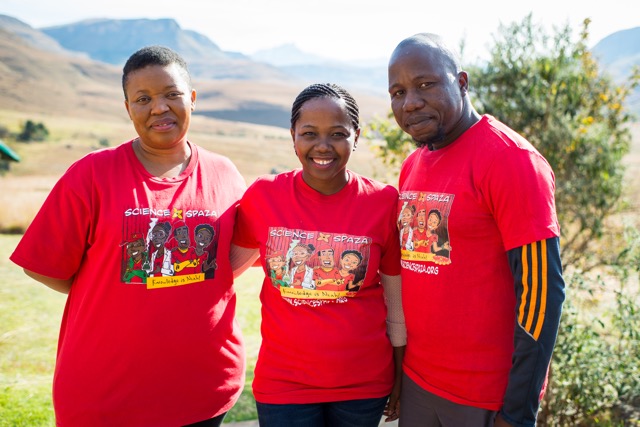THE INCREDIBLE THREE
Meet the three amazing scientists who joined us on the trip to the ‘Berg. First, we talked to Dr Nonny Vilakazi whose life’s work is reptile fossils; then to Dr Thakane Ntholi who studies rocks; and lastly, Dr Ndukuyakhe Ndlovu who knows a thing or two about San rock art.

From left to right: Dr Nonny Vilakazi, Dr Thakane Ntholi, Dr Ndukuyakhe Ndlovu
Profile of Dr Nonny Vilakazi, UNISA
Q: What is your home town – and how did you become interested in palaeo-herpetology?
I grew up in Mofolo Central, Soweto.
I got in by chance. Originally I wanted to be a medical doctor but then I fell in love with palaeontology while doing my final year BSc Zoology at Wits University. My PhD supervisor, Prof Lee Berger, suggested this specialty to me as no one was researching it in South Africa, or in Africa, for that matter. I then decided to pursue it and the rest is history.
Q: Please give a short description of your work
I’m a palaeo-herpetologist (studying reptile fossils). I am currently a Senior Lecturer at UNISA, teaching Archaeology, and doing research, studying reptiles (more like describing them) from Bolt’s Farm at the Cradle of Humankind.
Q: What kind of reptile fossil would you like to be and why?
I’d be a Massospondylus because I’ve always wanted to be tall, harmless and vegetarian. That’s one of the most beautiful dinosaurs I know. So humble.
Q: What is most interesting about the reptile fossil record of South Africa?
A lot of people tend to focus on dinosaurs and that’s cool, but a lot still needs to be done on the snake and lizard phylogeny [the evolutionary development of a species] and that’s what I’m trying to do. No one really knows about our African snake and lizard origins.
Q: What are the present-day implications of some of the discoveries made in palaeo-herpetology?
Our reptiles (snakes especially) are indicator species and by discovering them, it will tell us more about the environment of the past. This in turn will help us get an idea and verify or disprove what we’ve already been told about our palaeo-environment (the environment of the distant past). The results can also help us in understanding the changes we experience today.
Q: Where can we find some of the reptile fossil hotspots in South Africa?
Karoo and Cradle of Humankind. There are many hotspots in other parts of the world: Jurassic Coast (USA), Egypt, Niger, Madagascar, Morocco, Tanzania and Europe, to name just a few.
Q: What advice would you give learners who want to pursue a career in the palaeo-sciences?
You don’t have to be an A student to do the sciences, BUT be dedicated, patient, learn from your mistakes and work harder. Nothing beats hard work. Remember, anyone willing to get their hands dirty can do this J
Profile of Dr Thakane Ntholi, Council for Geosciences
Q: What is your hometown – and how did you become interested in geology?
My hometown is Thaba Nchu in the Free State.
My initial interest was environmental science. I registered for a BSc Earth Sciences at UCT. The introductory course incorporated both geology and environmental science. In that course I realized that environmental stewardship is best tackled when you have a clear understanding of the processes that make the resources and the related mining methods. I then decided to take the geology stream, and in time, I fell in love with geology as a whole.
Q: Please give a short description of your work
My work focuses on doing research towards successful implementation of passive treatment technologies for acid mine water at abandoned mine sites and affected areas. Additionally, I perform life cycle assessment on different treatment technologies to determine which of them will have the least environmental impact over time.
Q: What kind of rock would you like to be and why?
I would be a kimberlite. These are the rocks from which diamonds are mined and I would love to be the host of such rare treasures. Additionally, kimberlites are named after our very own town of Kimberley where an 83.5 carat diamond was discovered and led to the boom of diamond mining.
Q: Tell me why some school learners should consider geology as a career option?
South Africa is a country that is rich in mineral deposits. To date, companies are still exploring for new resources to mine. Geologists are key in identifying the mineral deposits because they have a good understanding of the processes that form them. It would be amazing to have more South African geologists study and publish information on the rocks that are right in our backyard.
Q: Please explain the significance and relevance of your line of work in society?
My work focuses on treating mine water that might contaminate our fresh water resources, and in some areas it has already begun to contaminate. With the water shortage, not just in South Africa but in the world, every megalitre we can save goes a long way. In areas where treatment has been successful, the ecosystems such as wetlands have recovered and become close to their original state.
Q: Could you please tell us more about interesting geological features in South Africa and how those areas could be exploited for science tourism?
Barberton - At this site you can see some of the oldest rocks on earth (3.6 billion years) which also contain evidence of the first signs of life on earth.
Sudwala Caves - Believed to be the oldest caves in the world at 240 million years old. Stone tools used by our predecessors have been found in the caves, suggesting that they have been used for shelter from as early as 1.8 million years ago.
Profile of Dr Ndukuyakhe Ndlovu, University of Pretoria
Q: What is your hometown – and how did you become interested in rock art?
I was born at Osizweni, a township in Newcastle.
My interest in rock art came as a result of poor career guidance while I was still at school. From 1991 when I went to high school, I was clear in my mind that I wanted to study Mechanical Engineering. However, I could not study towards my desired degree at the University of Witwatersrand. Instead of going to the Witwatersrand Technikon where I qualified for entry, I decided to stay at the University of the Witwatersrand. This decision was largely influenced by my view that Technikons were of a lower academic value, thus I was prepared to change degrees just to study at a university.
I wanted to challenge the notion that there were no Africans employed anywhere in South Africa as archaeologists. I got registered for a Master’s Degree in Archaeology, majoring in Rock Art Studies. When I finished my studies, I then took a four-year break before registering for my PhD in Archaeology (Rock Art) at Newcastle University in the United Kingdom.
Q: Please give a short description of your work
I currently teach archaeology to undergraduate and postgraduate students at Wits University. Besides the teaching, I supervise a number of Honours, Masters and Doctorate students who specialise in rock art and heritage management. In addition, I have a number of responsibilities within academia: (i) Editor-in-Chief for the South African Archaeological Bulletin, (ii) Secretary-General for the World Archaeological Congress, (iii) Council member for the Association of Southern African Professional Archaeologists (ASAPA) and (iv) Council member for the South African Archaeological Society (SAAS).
Q: What kind of rock art painting would you like to be and why?
An eland – the reason is not just informed by the view that these animals are most significant to Bushmen societies [elands are associated with rainmaking]. I visited a rock art site in Ladybrand in 1998 and, while I was looking at a painting of an eland, I felt my hair rising – a feeling I could not explain. I traced that eland and kept the tracing for many years. Last year I went to the same site with my undergraduate students to live the experience all over again.
Q: Why do you find rock art interesting as a discipline?
I find it interesting because it is one of the sub-disciplines of archaeology that provides us with an insight into the past. I strongly subscribe to the view expressed by Sir Seretse Khama (the First Democratically elected President of Botswana) in 1970: "A nation without a past is a lost nation, and a people without a past is a people without a soul."
Q: The Drakensberg has over 45 000 paintings. Which, would you say, are those that best tell of the life of the San people?
Rather than fall for the temptation of choosing selected paintings, I cannot pick out any specific paintings. This is because they tell different stories, depending on how the concerned researcher interprets them.
Q: The eland is heavily represented in the rock paintings. Please tell us more about the significance of this animal in the San context?
The general view is that eland are indeed the most represented, and thus important, animals in southern African rock art. However, I do not share the same view as this extremely generalised thinking. This is because eland dominate in selected areas, which have also been the most studied landscapes in southern Africa. The ethnographic records largely relied upon have also originated from areas where eland dominate in the rock art. There has been no explanation offered as to the regional variation in animal representation. Thus, I argue that eland significance should be geographically defined and not generalised like it presently is in southern African rock art studies.
See National Science Week 2017
